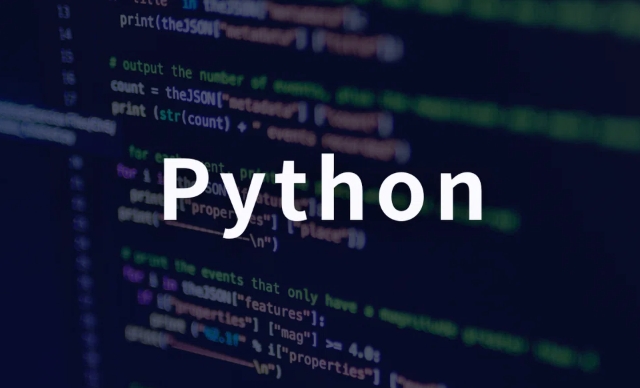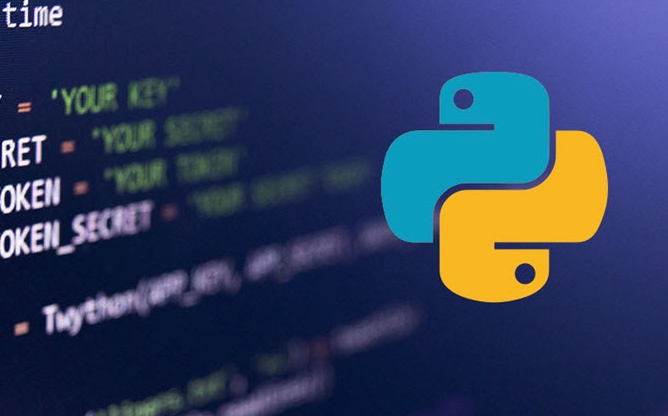subprocess.run() is a recommended method for running external commands in Python, which is safer and more powerful than os.system. 1. Basic usage: Use a list to pass commands and parameters, such as subprocess.run(['ls', '-l'], capture_output=True, text=True), and the return result contains the return code, standard output and error. 2. Use shell to execute complex commands: support shell features such as pipelines through shell=True, such as subprocess.run('echo "hello" | grep "hello"', shell=True, capture_output=True, text=True), but it should be avoided for user input to prevent injection risks. 3. Check the command successfully: Set check=True to throw a CalledProcessError exception when the command fails, which is convenient for error handling. 4. Pass environment variables: Pass into the custom environment through the env parameter, such as copying os.environ and adding new variables. 5. Real-time output: subprocess.run() does not support real-time output by default. Capture_output can be omitted and output directly to the terminal, or use subprocess.Popen to implement streaming reading instead. 6. Common parameters include args, shell, capture_output, text, check, timeout, cwd and env. Reasonable combination can meet the needs of most scenarios. It is recommended to use list-form commands to improve security, and finally complete external command calls in a concise and safe way.

subprocess.run() is a common method used in Python to run external commands. It belongs to the subprocess module and is recommended to use it since Python 3.5. It is more powerful and safer than old methods such as os.system or subprocess.call , and supports rich parameter configuration.

Below are some practical subprocess.run() examples to help you get started quickly.
? Basic usage: Run simple commands
import subprocess
# Run the ls command (Linux/macOS) or dir (Windows)
result = subprocess.run(['ls', '-l'], capture_output=True, text=True)
print("Return code:", result.returncode)
print("Output:", result.stdout)
print("Error:", result.stderr)Notice:
- Commands and parameters are passed in a list form to avoid the risk of shell injection.
capture_output=Truecaptures standard output and standard errors.text=Trueconverts the output from bytes to string.
? Use shell to execute complex commands (such as with pipes)
import subprocess
result = subprocess.run(
'echo "hello world" | grep "hello"',
shell=True,
capture_output=True,
text=True
)
print("Output:", result.stdout)?? Note:
shell=Truehas security risks, do not use it on user input.
? Check whether the command is successful (exception is automatically thrown)
import subprocess
Try:
result = subprocess.run(
['python', '--version'],
check=True, # Throw CalledProcessError when failure
capture_output=True,
text=True
)
print("Success:", result.stdout)
except subprocess.CalledProcessError as e:
print("Command execution failed, return code:", e.returncode)? Pass environment variables
import subprocess
import os
custom_env = os.environ.copy()
custom_env["MY_VAR"] = "hello"
result = subprocess.run(
['python', '-c', 'import os; print(os.getenv("MY_VAR"))'],
env=custom_env,
capture_output=True,
text=True
)
print("Environment variable output:", result.stdout)? Real-time output (not recommended to use run, use Popen instead)
subprocess.run() is to wait for the command to end before returning, which is not suitable for real-time output. If you need real-time printout, you should use subprocess.Popen .

But if you still want to use run and print the output, you can do this:
import subprocess # Do not capture the output, print directly to the terminal subprocess.run(['echo', 'Hello, World!'])
Or output while executing (requires to close capture):
subprocess.run(['ls', '-l'], text=True) # The output will be printed directly
? Common parameters summary
| parameter | illustrate |
|---|---|
args
|
Commands and parameters (lists or strings) |
shell=True
|
Execute using shell interpreter (use with caution) |
capture_output=True
|
Capture stdout and stderr |
text=True
|
Output as a string instead of bytes |
check=True
|
When the return code is not 0, the exception is thrown |
timeout=10
|
Timeout setting (seconds) |
cwd='/path'
|
Specify the working directory |
env=...
|
Custom environment variables |
Basically these common scenarios. For most script tasks, subprocess.run() is sufficient with capture_output=True and text=True , which is safe and concise.
The above is the detailed content of python subprocess run example. For more information, please follow other related articles on the PHP Chinese website!

Hot AI Tools

Undress AI Tool
Undress images for free

Undresser.AI Undress
AI-powered app for creating realistic nude photos

AI Clothes Remover
Online AI tool for removing clothes from photos.

Clothoff.io
AI clothes remover

Video Face Swap
Swap faces in any video effortlessly with our completely free AI face swap tool!

Hot Article

Hot Tools

Notepad++7.3.1
Easy-to-use and free code editor

SublimeText3 Chinese version
Chinese version, very easy to use

Zend Studio 13.0.1
Powerful PHP integrated development environment

Dreamweaver CS6
Visual web development tools

SublimeText3 Mac version
God-level code editing software (SublimeText3)
 VSCode settings.json location
Aug 01, 2025 am 06:12 AM
VSCode settings.json location
Aug 01, 2025 am 06:12 AM
The settings.json file is located in the user-level or workspace-level path and is used to customize VSCode settings. 1. User-level path: Windows is C:\Users\\AppData\Roaming\Code\User\settings.json, macOS is /Users//Library/ApplicationSupport/Code/User/settings.json, Linux is /home//.config/Code/User/settings.json; 2. Workspace-level path: .vscode/settings in the project root directory
 How to handle transactions in Java with JDBC?
Aug 02, 2025 pm 12:29 PM
How to handle transactions in Java with JDBC?
Aug 02, 2025 pm 12:29 PM
To correctly handle JDBC transactions, you must first turn off the automatic commit mode, then perform multiple operations, and finally commit or rollback according to the results; 1. Call conn.setAutoCommit(false) to start the transaction; 2. Execute multiple SQL operations, such as INSERT and UPDATE; 3. Call conn.commit() if all operations are successful, and call conn.rollback() if an exception occurs to ensure data consistency; at the same time, try-with-resources should be used to manage resources, properly handle exceptions and close connections to avoid connection leakage; in addition, it is recommended to use connection pools and set save points to achieve partial rollback, and keep transactions as short as possible to improve performance.
 python itertools combinations example
Jul 31, 2025 am 09:53 AM
python itertools combinations example
Jul 31, 2025 am 09:53 AM
itertools.combinations is used to generate all non-repetitive combinations (order irrelevant) that selects a specified number of elements from the iterable object. Its usage includes: 1. Select 2 element combinations from the list, such as ('A','B'), ('A','C'), etc., to avoid repeated order; 2. Take 3 character combinations of strings, such as "abc" and "abd", which are suitable for subsequence generation; 3. Find the combinations where the sum of two numbers is equal to the target value, such as 1 5=6, simplify the double loop logic; the difference between combinations and arrangement lies in whether the order is important, combinations regard AB and BA as the same, while permutations are regarded as different;
 Mastering Dependency Injection in Java with Spring and Guice
Aug 01, 2025 am 05:53 AM
Mastering Dependency Injection in Java with Spring and Guice
Aug 01, 2025 am 05:53 AM
DependencyInjection(DI)isadesignpatternwhereobjectsreceivedependenciesexternally,promotingloosecouplingandeasiertestingthroughconstructor,setter,orfieldinjection.2.SpringFrameworkusesannotationslike@Component,@Service,and@AutowiredwithJava-basedconfi
 python pytest fixture example
Jul 31, 2025 am 09:35 AM
python pytest fixture example
Jul 31, 2025 am 09:35 AM
fixture is a function used to provide preset environment or data for tests. 1. Use the @pytest.fixture decorator to define fixture; 2. Inject fixture in parameter form in the test function; 3. Execute setup before yield, and then teardown; 4. Control scope through scope parameters, such as function, module, etc.; 5. Place the shared fixture in conftest.py to achieve cross-file sharing, thereby improving the maintainability and reusability of tests.
 Python for Data Engineering ETL
Aug 02, 2025 am 08:48 AM
Python for Data Engineering ETL
Aug 02, 2025 am 08:48 AM
Python is an efficient tool to implement ETL processes. 1. Data extraction: Data can be extracted from databases, APIs, files and other sources through pandas, sqlalchemy, requests and other libraries; 2. Data conversion: Use pandas for cleaning, type conversion, association, aggregation and other operations to ensure data quality and optimize performance; 3. Data loading: Use pandas' to_sql method or cloud platform SDK to write data to the target system, pay attention to writing methods and batch processing; 4. Tool recommendations: Airflow, Dagster, Prefect are used for process scheduling and management, combining log alarms and virtual environments to improve stability and maintainability.
 Troubleshooting Common Java `OutOfMemoryError` Scenarios
Jul 31, 2025 am 09:07 AM
Troubleshooting Common Java `OutOfMemoryError` Scenarios
Jul 31, 2025 am 09:07 AM
java.lang.OutOfMemoryError: Javaheapspace indicates insufficient heap memory, and needs to check the processing of large objects, memory leaks and heap settings, and locate and optimize the code through the heap dump analysis tool; 2. Metaspace errors are common in dynamic class generation or hot deployment due to excessive class metadata, and MaxMetaspaceSize should be restricted and class loading should be optimized; 3. Unabletocreatenewnativethread due to exhausting system thread resources, it is necessary to check the number of threads, use thread pools, and adjust the stack size; 4. GCoverheadlimitexceeded means that GC is frequent but has less recycling, and GC logs should be analyzed and optimized.
 How to work with Calendar in Java?
Aug 02, 2025 am 02:38 AM
How to work with Calendar in Java?
Aug 02, 2025 am 02:38 AM
Use classes in the java.time package to replace the old Date and Calendar classes; 2. Get the current date and time through LocalDate, LocalDateTime and LocalTime; 3. Create a specific date and time using the of() method; 4. Use the plus/minus method to immutably increase and decrease the time; 5. Use ZonedDateTime and ZoneId to process the time zone; 6. Format and parse date strings through DateTimeFormatter; 7. Use Instant to be compatible with the old date types when necessary; date processing in modern Java should give priority to using java.timeAPI, which provides clear, immutable and linear







